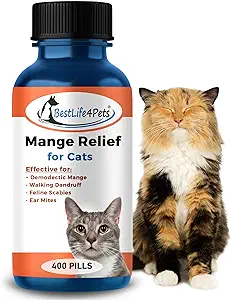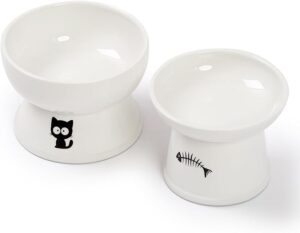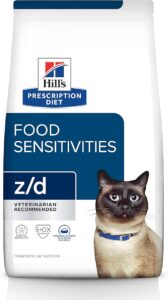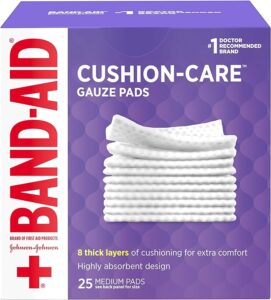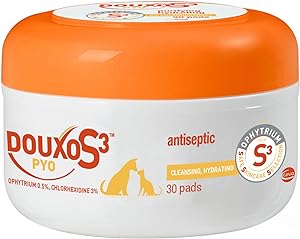How do crusts and scabs form on your cat's nose?
Generally, a crusty nose in your cat is almost always a result of dried-on moisture from your cat’s environment, simply a piece of dirt. Sometimes, it can also be dried up snot bubbles. If your cat’s skin sustains any damage, tissue fluid can seep from the nasal skin and dry up into crusts on your cat’s nose, not to mention blood from wounds. If the scabs and crusts do not heal, and your cat is a senior, unfortunately, there is a good chance that your cat is suffering from cancer, specifically, a squamous cell carcinoma.
black scabs on your cat's nose: dirt
In the vast majority of cases, your cat has just played outside or sniffed your plants and now has some dried up soil in the form of crusts on its nose. This looks like a brown rim on his nose. This is very local, usually on the upper edge of the nose. You easily wipe it off with a damp cloth.
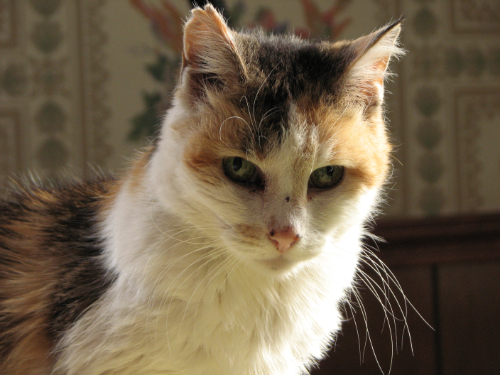
Snot crusts
If your cat has a snotty nose, it dries up on its nose, especially on the rhinarium. In this case, the scabs on your cat’s nose are quite easy to remove with a wet cloth. The snot bubbles often result from an upper respiratory infection. Cat flu, in particular, causes crusts on the nose in a cat. Sometimes, cats also have a piece of grass in their nose, leading to a purulent (white, yellow, or green) discharge from the nose. If your cat loses a lot of snot or pus from its nose, it is best to visit your vet. The vet can then determine whether your cat needs a course of antibiotics or whether there is probably something stuck in its nose that won’t come out.
Wounds on your cat's nose
When a cat has wounds on its nose in one way or another, those wounds often bleed. This blood will eventually clot and form a crust. As long as the crust looks okay and your cat is not too bothered by it, you don’t have to treat this. It heals on it’s own. (Unless it is cancer…)
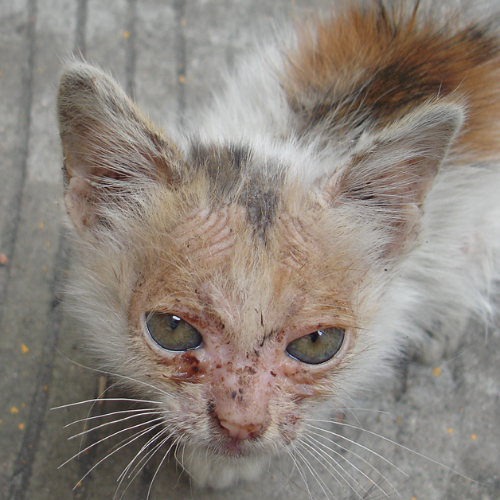
mites
Mites generally consider a cat’s head a wonderful place to live. Depending on the mite species, they can live superficially on the skin or very deep in the hair follicles. They cause damage to the skin, making fluid seep out of the tissue and resulting in crusts on your cat’s nose. Sometimes, this takes extreme forms. You can treat mites with various means, but you can only get them at your vet’s counter. In general, vets usually use Stronghold, Advocate, or Bravecto. If you prefer a milder treatment, you can try Mange relief for cats.
allergies
Allergic reactions generally cause itching and skin inflammation all over the body, with an emphasis on the head. In some cases, only the nasal skin plays a role. Here too, the tissue of the skin has been damaged by the allergic reaction, causing fluid to seep from the tissue and dry up on the bridge of the nose. This is how crusts form on your cat’s nose in this case.
Food allergy
In addition, there may be a food allergy. To determine this, your cat may only receive a special food for 8 weeks that does not contain any substances to which it can react allergically. The best food for a food allergy is Hill’s Z/D. During the 8 weeks that your cat receives this, he should absolutely not eat anything else. No candies, no things from your fridge, nothing. Only his special food. You will not see any changes for the first 4 weeks. But in the last 4 weeks you can see his nose recover if he really has a food allergy. If it is clear that he has an allergy, you can try whether the less strong, and therefore cheaper, foods against allergies also work sufficiently for your cat. But first you need to know for sure if it’s a food allergy.
Atopic allergy
The only allergy that you cannot solve yourself is the atopy. This is an allergic reaction based on environmental substances in the air. So tree pollen, grass pollen, house dust mites, etc. If you feel that this could be the cause of your cat, it is wise to go to your vet. He can investigate further. For example, a blood test. He or she can also choose to prescribe medication.
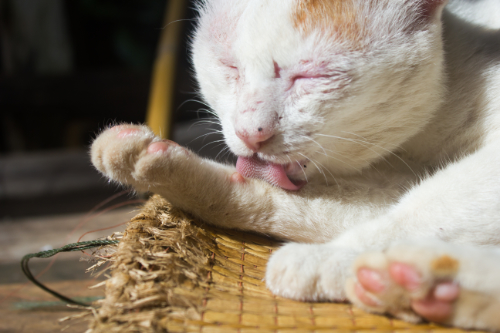
autoimmune disorders
An autoimmune disorder is a disease in which your cat’s immune cells attack its own tissues. Error in the immune system. In this case, the skin cells of his nose are attacked. This can be determined by your vet. He will anesthetise your cat and take a piece of skin from his nose. This is then sent to a laboratory. Fortunately, autoimmune disorders in cats are not very common.
Cancer of the nose: squamous cell carcinoma
If you have an older cat and it has had a crust on its nose for weeks to months that won’t heal, unfortunately this is usually a squamous cell carcinoma, or nasal cancer. Your vet may be able to take some cells from this crust and send them for testing to make a definitive diagnosis.
If it is indeed a squamous cell carcinoma in your cat and you catch it early, treatment is possible. A treatment is expensive and very intensive for your cat, but it is worth trying. For example, we are thinking of amputation of (part of) the nose, radiation, chemotherapy, burning away the cancer or freezing the cancer resulting in the death of the cancer. None of them have an ideal outcome and none of them have a high chance of success. Only about 1 in 10 cats recover from the cancer and are still alive a year later. Many people therefore choose not to go this route.
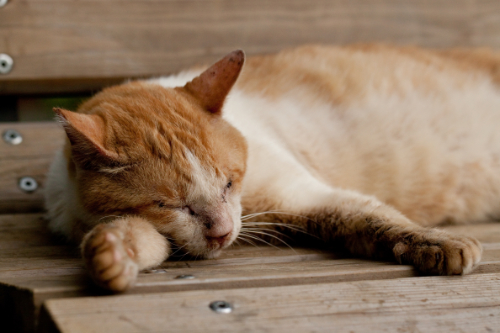
What to do about the scabs on your cat's nose?
Disinfect if necessary.
If mild skin damage can be seen on the nose, it is wise to clean your cat’s nose twice a day with chlorhexidine wipes. Usually 5-7 days of cleaning is enough for the nose to heal. The chlorhexidine kills bacteria so that any infection is prevented and treated. As long as there is no infection, normal skin wounds can heal well.
Does your cat have an upper respiratory infection?
In that case, cat flu is the likely cause. This can last for about 2 to 3 weeks. After that, most cats are recovered. In a few cases, however, chronic cat flu can develop with lifelong symptoms of cat flu. As a result of the snotty nose, scabs appear on the rhinarium. You can remove this with the pads above. If the flu symptoms become too bad, it is wise to visit your vet. They will probably prescribe you a course of antibiotics and possibly fever lowering medicine. But with mild complaints, this is neither necessary nor useful. After all, cat flu is caused by a virus and antibiotics do not work against viruses. We only give antibiotics if we think a bacterial infection has come on top of a viral infection.
Are the crusts on your cat's nose flaky en scaly?
In that case, a mite is the most likely cause of your cat’s nose scabs. You should therefore give a mite treatment for at least 2 months. See earlier in this article for getting the right resources.
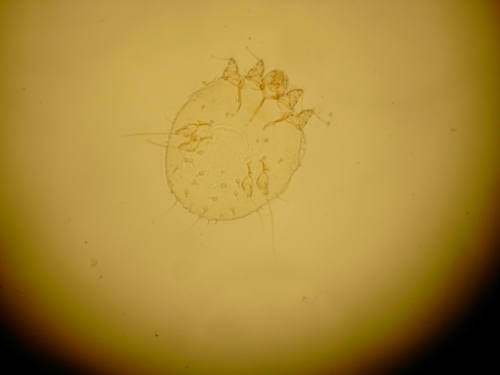
Analysis of the risks
Is your cat an older cat and does it mainly seem to be a clear crust from a wound on your cat’s nose? Then it is wise to go to your vet. The earlier a diagnosis of nasal cancer can be made, the greater the chance that he can recover from it. Nasal cancer is most common in cats with a white or light colored nose. It is known that UV rays contributes to the formation of nasal cancer in your cat. And pigmented skin blocks more UV radiation than white skin.
If the crusts only concerns a younger cat of about one or two years old, the chance of an allergic reaction is greatest. In that case, it is wise to start the process of the food allergy test. If that does not solve the problem and your cat still has crusty wounds on its nose, it is wise to call in your vet for further investigation. In rare cases, it can also be an autoimmune condition and you will need to see your vet for this as well.
Hopefully he will recover soon
We hope you have received enough information to get rid of the crusts on the nose of your cat. Hopefully his nose will be nice and healthy again soon. Good luck!

